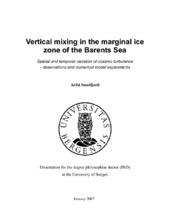| dc.contributor.author | Sundfjord, Arild | eng |
| dc.date.accessioned | 2007-01-18T10:40:06Z | |
| dc.date.available | 2007-01-18T10:40:06Z | |
| dc.date.issued | 2007-01-12 | eng |
| dc.identifier.isbn | 82-308-0297-1 (print version) | en_US |
| dc.identifier.uri | https://hdl.handle.net/1956/2069 | |
| dc.description.abstract | Vertical mixing affects water mass modification, biological productivity, and chemical fluxes in the ocean, but its response to forcing and variability in time and space in seasonally ice-covered seas is inadequately known. As part of an interdisciplinary project, CABANERA, drop-sonde microstructure measurements were made during ice drift stations in the marginal ice zone (MIZ) of the northern Barents Sea in 2004 and 2005. Turbulent diffusivity rates in the surface mixed layer, pycnocline, and deeper stratified waters, inferred from the measurements, were found to vary greatly. Concurrent observations of fine-scale currents and wind, and predictions from a tidal model allowed for events of enhanced turbulence to be attributed to wind episodes and strong tides, and relationships explaining e.g. the upper-ocean vertical distribution of diffusivity as function of wind speed to be established. The large measured dissipation values were supported through independent estimates of water column overturning scales. In low-energy areas in the interior MIZ, double diffusive convection was found to produce significant heat fluxes. The processes producing and dissipating turbulent energy are not fully understood, and the added complexity of the variable ice cover in the MIZ aggravates the challenges associated with prediction and modelling of turbulence in this region. In this study we performed model simulations of ice and ocean dynamics for the three project years, with a special emphasis on vertical mixing. Large-scale features such as inflow of Atlantic Water and exchange of ice with the adjacent seas are described and compared with available observations. The seasonal development of diffusivity and stratification is presented, from the vertically near-homogeneous winter situation through the highly stratified melting season and into the ice-free summer. Differences between two mixing parameterization schemes are explored, and benefits of increasing both horizontal and vertical model grid resolution are identified. Finally, adaptations to improve the performance of the mixing parameterizations in MIZ applications are suggested. | en_US |
| dc.format.extent | 500183 bytes | eng |
| dc.format.extent | 2217812 bytes | eng |
| dc.format.extent | 1132987 bytes | eng |
| dc.format.extent | 3157556 bytes | eng |
| dc.format.mimetype | application/pdf | eng |
| dc.format.mimetype | application/pdf | eng |
| dc.format.mimetype | application/pdf | eng |
| dc.format.mimetype | application/pdf | eng |
| dc.language.iso | eng | eng |
| dc.publisher | The University of Bergen | en_US |
| dc.relation.haspart | Paper I: Sundfjord, A.; Fer, I.; Kasajima, Y. and H. Svendsen, (2006), Observations of turbulent mixing and hydrography in the marginal ice zone of the Barents Sea. Preprint. In press for publication in Journal of Geophysical Research – Oceans. Copyright American Geophysical Union. | en_US |
| dc.relation.haspart | Paper II: Fer, I.; and A. Sundfjord, (2006), Observations of upper ocean boundary layer dynamics in marginal ice zone. Preprint. In press for publication in Journal of Geophysical Research – Oceans. Copyright American Geophysical Union. | en_US |
| dc.relation.haspart | Paper III: Sundfjord, A.; Ellingsen, I.; Slagstad, D. and H. Svendsen, (2006), Vertical Mixing unt he MIZ of the Barents Sea – results from numerical model experiments. Preprint. Accepted for publication in Deep Sea Research-II. Copyright Elsevier. | en_US |
| dc.title | Vertical mixing in the marginal ice zone of the Barents Sea Spatial and temporal variation of oceanic turbulence - observations and numerical model experiments | en_US |
| dc.type | Doctoral thesis | |
| dc.subject.nsi | VDP::Matematikk og Naturvitenskap: 400::Geofag: 450::Marin geologi: 466 | nob |



